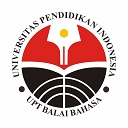Embbed Dajare Word Play Process in “Shirokuma Café”
Abstract
Pun, in English, is a word play that is very suitable for Japanese, which has many homonyms. The name of word play in Japanese is called dajare. Many experts mention the types of dajare, and one of the researchers mentioned that there are three types of dajare. These three of types are homophonic dajare, near-homophonic dajare, and embbed dajare. One of the three types of dajare is the main focus of research. This research explained the analysis of embbed dajare in an animated show titled ““Shirokuma Café””, the show that has a lot of dajare in conversations between Shirokuma and his friends which is seen from the vocabularies are used. The purpose of this research was to study how the embbed dajare word play process is used in the conversation between Shirokuma and the person he is talking to. The research method used is a descriptive qualitative method. The results of this research showed that the same or similarity of sound and form of dajare does not guarantee the similarity of meaning between the referent word and the target word.
Keywords
Full Text:
PDF (IDN)References
Berger, A. A. (2011). The Art of Comedy Writing. New Jersey: Transaction Publishers.
Chaer, A., & Agustina, L. (2014). Sosiolinguistik. Jakarta: Rineka Cipta.
Dybala, P., Rzepka, R., Araki, K., & Sayama, K. (2012). Japanese puns are not necessarily jokes. AAAI Fall Symposium - Technical Report, FS-12-02, 7–13. Retrieved from AAAI.
Fadilah, N. (2017). Pembentukan Dan Makna Kontekstual Dajare Pada Serial Kartun Doraemon Episode 452 (ダジャレでやっつけろ!). Goken, 5(3), 1-8. Retrieved from Jurnal mahasiswa Unesa.
Giorgadze, M. (2014). Linguistic Features of Pun, Its Typology, and Classification. European Scientific Journal, 2 (special), 271-275. Retrieved from European Scientific Journal.
Human Academy. (2014). Nihongo Kyouiku Nōryoku Kentei Shiken Kanzen Kouryaku Gaido (3th ed., pp. 41). Retrieved from Google Book.
Leech, G. (2003). Semantik. Yogyakarta: Pustaka Belajar.
Mahsun. (2017). Metode Penelitian Bahasa. Depok: PT. Rajagrafindo Persada.
Otake, T. (2010). Dajare is more Flexible than Puns: Evidence from Word Play in Japanese. Journal of the Phoetic Society of Japan, 14(1), 76–85. https://doi.org/10.24467/onseikenkyu.14.1_76
Shinohara, K. (2009). Designing Languange Games. Japanese Society for the Science of Design, 16-2(62). 44-49.
Viera, R. T. (2017). Vocabulary Knowledge in The Production of Written Texts: A Case Study on EFL Language Learners. Revista Tecnologica ESPOL - RTE, 30(3). 89-105. Retrieved from Revista Tecnologica.
DOI: https://doi.org/10.17509/japanedu.v5i1.23115
Refbacks
- There are currently no refbacks.
Copyright (c) 2020 JAPANEDU: Jurnal Pendidikan dan Pengajaran Bahasa Jepang

This work is licensed under a Creative Commons Attribution-ShareAlike 4.0 International License.
 Published by:
Published by: Department of Japanese Language Education, Faculty of Language and Literature Education
Universitas Pendidikan Indonesia
 Online ISSN: Online ISSN:2528-5548 |

JAPANEDU: Jurnal Pendidikan dan Pengajaran Bahasa Jepang (e-ISSN:2528-5548) lisenced under a Creative Commons Attribution-ShareAlike 4.0 Internasional (CC BY-SA 4.0)


